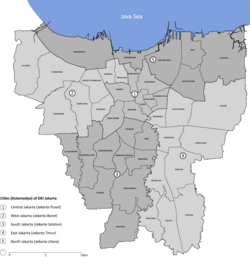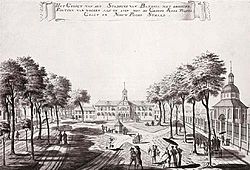 The front view of the museum seen from the Fatahillah Square (Indonesian: Taman Fatahillah) | |
| Established | 1707 |
|---|---|
| Location | Jl Taman Fatahillah 1, Jakarta Barat, Jakarta, Indonesia |
| Type | History museum |
| Visitors | 69,708 (2006) [1] 75,067 (2007) [1] |
| Public transit access |
|
| Website | Jakarta History Museum |
The Jakarta History Museum (Indonesian : Museum Sejarah Jakarta), also known as Fatahillah Museum or Batavia Museum, is located in the Old Town (known as Kota Tua) of Jakarta, Indonesia. The building was built in 1710 as the Stadhuis (city hall) of Batavia. Jakarta History Museum opened in 1974 and displays objects from the prehistory period of the city region, the founding of Jayakarta in 1527, and the Dutch colonization period from the 16th century until Indonesia's Independence in 1945.
Contents
- History
- The VOC
- Dutch colonial government
- Post-independence
- Architecture
- Collections
- Conservation
- See also
- References
- Further reading
- External links
The museum is located in south side of Fatahillah Square (former Batavia city square) near Wayang Museum and Fine Art and Ceramic Museum. The building is believed to be modeled after Dam Palace. [2]









